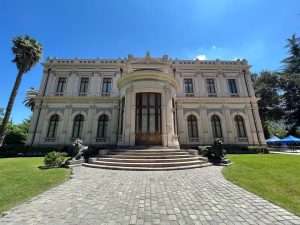Fungi Kingdom: Fungi in Chile and the Best Season to See Them
By: Hernan Claro - 17 May, 2023

The Fungi Kingdom has a vital importance for the ecosystem. They are the main decomposers of organic matter and a fundamental part of the natural cycle, that is why, at Chile Travel, we want to tell you about the diversity of fungi that we have in our country and what you should know to get to know them.
Main photo: @leelotz
Fungi in Chile and their location

Mycena cyanocephala is characterized by its beautiful blue tones. @fungis.chile
In Chile, it is considered that you can find more than 3,000 different kinds of mushrooms, a large number that is largely explained by the diversity of climates that can be found in our country. From the Coquimbo Region to the Antarctic and from the coast to the mountains, in Chile we can find a diversity of flora, fauna and funga which are very privileged in the world.
Among all this diversity, some mushrooms stand out as the most characteristic of our country in different areas:
- Mycena cyanocephala, from central Chile to Patagonia in the coastal sclerophyllous forest.
- Entoloma necopinatum, very rare, seen between Biobío and Los Lagos, also found in Chiloé.
- Amanita Muscaria, one of the most famous mushrooms in the world, introduced in Chile and now seen in some areas of Biobío.
- Cortinarius magellanicus, from the Maule area to Magallanes, with a characteristic pink and small size.
- Grifola gargal, between the areas of Biobío and La Araucanía, grows on branches and stems of Nothofagus trees.
- Cyptotrama hygrocyboides, between Fray Jorge and the Maule area, grows on dead trunks in shady places.
- Atheniella adonis, in the southern zone of Chile up to Patagonia, it is not autochthonous to our country.
- Anthracophyllum discolor, grows from Coquimbo to Biobío, it is native to Chile and Argentina.
Fungi season in Chile

An Entoloma necopinatum can be mistaken for plants because of its greenness. @giulifungi
The autumn season is very special for this kingdom, as it gives us incredible experiences such as exploring with a magnifying glass what is growing silently. It is the best time to see trails with the presence of Amanitas Muscaria, Clavaria Zollingeri or Cortinarius Magellanicus, which impress with their bright colors and textures. It is also a particularly good time to stop and observe with a magnifying glass to appreciate that there are not one or two specimens, but hundreds that populate the ground, branches, and trunks.
If you want to learn more about the experiences around this kingdom, in Los Ríos Region you can discover this world through guided expeditions and events that bring scientific and ancestral knowledge and its different expressions. Do not forget to take out only tourist services registered with Sernatur.
Learn more about the Fungi Kindgom

Cortinarius magellanicus has a striking color. @rafael_arroyo_castro
If you want to learn more about the fungi kingdom in Chile, you can head to Los Lagos Region to go on a guided expedition or go directly to the Araucanía Region, particularly to Pucón, where the Festival Reino Fungi takes places from May 12th to 14th.
These areas are not only ideal for funga observation, but also to have different expeditions and workshops where you can learn more about this kingdom, how to appreciate and protect it.
Care in handling fungi

The impressive structure of a Grifola gargal. @dine_cortinaria
It is important to take care of the fungi kingdom and ourselves when we interact with them, so we must keep in mind certain aspects:
- Gather information and learn. Look at the guides and explore together with someone who is knowledgeable. Just as you cannot harvest any plant, the same goes for fungi. It is important to know how to differentiate a potential poisonous fungus.
- When harvesting a medicinal or edible one, we recommend you go out with baskets because in that way, you can release the spores that fall through the spaces in the basket.
- Make a clean cut with a knife because it generates less damage to the organism.
- Do not step on mushrooms. Keep the forest as intact as possible. Use trails. Do not remove logs or decaying trees that are sources of life for fungi.
- Always leave half of the mushroom that is growing. These play the role of reproduction, so it is important to let them mature.



















